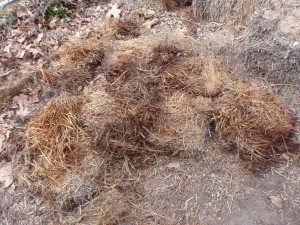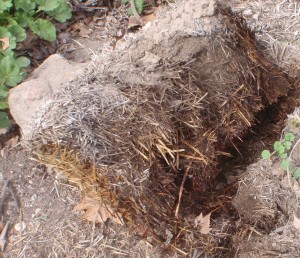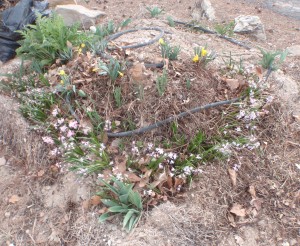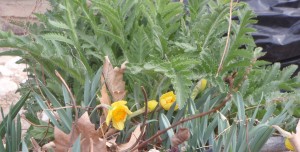
A few days ago I needed to break up one of my 3 straw bale gardens in order to set up a chicken pen. This particular straw bale garden was just beginning its third spring. All of it, dirt and straw, has been watered regularly with drip irrigation. I have grown vegetables such as zucchini, lettuce, and tomatoes on it. But the end of the chicken pen needed to go right through the middle of it, so it had to go
The outer edges of the mound were still obviously straw that a shovel would not cut through. I began to pull chunks of straw away and found that it was still basically a mat of straw all the way to the dirt center. The middle of the straw bale garden had been filled with composted dirt from the adjacent chicken yard. It was good soil, except for the bits of clay and rock that had stowed away and kept pushing their way to the top.

There were a few levels of deterioration to be noted in the straw. Right next to the soil, there was about an inch of straw that seemed to be seriously thinking about giving in to the composting process. The straw was visible, but beginning to break down into smaller pieces. If the whole straw bale garden had been like this, I could probably have dug it with a shovel.
The middle portions of the straw were slightly moldy and still came apart in flat sections, like straw does in a fresh bale. I laid some of these straw tiles around as a layer of 2 inch mulch in the nearby flower bed. Most of the flowers are perennials that already have a mass of green foliage, so the tiles hid reasonably under them. Also, there is a line of hollyhocks and butterfly bush right along the fence that block the view of the ground some.

The outer layer of the straw bale garden was just a very dry, dull gray. Much of it was already falling away in sections due to gravity. Those pieces I tossed over into the chicken yard in hopes of future decomposition with the help of chicken feet.
My first straw bale garden, which is on it’s 4th spring, is just a few feet away on the other side of the driveway, so I decided it was a good time to compare them. It has basically functioned as a large container, so that I could brighten up the driveway entry, but limit the watering to keep the weeds more controlled. Here are some pros and cons to how it is working for me.

Cons first:
- It has tended to keep sinking, particularly making a gulch just inside the outer edge. This means that bulbs that were planted there early on have sunk. I am going to try adding a shallow layer of dirt every year, so that the bulbs won’t get too deep, but the mound won’t look so weird.
- It still doesn’t hold water well. This means that water will tend to run out the bottom before the whole garden has been soaked enough. I am wondering if there is some sort of border that I could put up around it to help contain the water. Maybe just a miniature dirt berm would be enough?
- The straw is still pretty tight, so it can be hard to both plant and weed, compared to good soil anyway.
- Rocks and clay pieces seem to keep rising to the top of the soil dug from the original chicken pen. This is not the fault of the straw bales, but the overall structure makes it fall outside of the normal ways of tending the soil. I have periodically hand picked some of the debris away.
Pros now:
- I like the easy way of adding height variation for visual effect.
- It was relatively easy to set up, although I’m not sure it wouldn’t have been just as easy to build a big square raised bed with something else for sides. The straw was purchased in bulk, though, so it only cost me about $4. That’s hard to beat.
- It is a good height for tending without as much back strain.
- The annual poppies, sweet peas, four o’clocks; perennial poppy and day lily; and bulbs seem to like it there just fine. The annuals have been reseeding easily. The mint I planted last year is happy, too.
Would I do it again? Probably. Like I mentioned, it’s hard to find a less expensive way of making a raised bed. It was a construction that I could manage by myself. And it has just been fun to fool around with it. I would consider starting it as early as possible in the spring and maybe giving it some time under some black plastic, to get it cooking faster. The plastic would need to be easy to remove regularly for watering. There are not any permanent plantings in the other remaining straw bale garden, so I think I’ll try that there!

